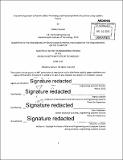| dc.contributor.advisor | Nancy Leveson and Stan Finkelstein. | en_US |
| dc.contributor.author | Samost, Aubrey | en_US |
| dc.contributor.other | Massachusetts Institute of Technology. Engineering Systems Division. | en_US |
| dc.date.accessioned | 2015-10-14T15:06:07Z | |
| dc.date.available | 2015-10-14T15:06:07Z | |
| dc.date.issued | 2015 | en_US |
| dc.identifier.uri | http://hdl.handle.net/1721.1/99329 | |
| dc.description | Thesis: S.M., Massachusetts Institute of Technology, Engineering Systems Division, 2015. | en_US |
| dc.description | "June 2015." Cataloged from PDF version of thesis. | en_US |
| dc.description | Includes bibliographical references (pages 55-57). | en_US |
| dc.description.abstract | Patient safety has become a critical concept in healthcare as clinicians seek to provide quality healthcare to every patient in a healthcare system that has grown far more complex than the days of the independent doctor and his black bag making house calls. Accidents in present-day healthcare systems are complicated, with environmental factors, interactions between clinicians, and the pressures exerted by managerial decisions all contributing to these medical mishaps. Despite this complexity, accidents are analyzed using simplistic and outdated techniques modeling systems as mere linear chains of events, when the reality lies far from those neat cause and effect relationships. Further compounding efforts to promote patient safety is the reliance on reactive approaches to safety, waiting for accidents to occur before enacting changes, like a dangerous game of whack-a-mole. What little work is done in prospective hazard analysis tends to be concentrated in niche areas and relies heavily on older analytic techniques. This thesis demonstrates the use of systems theory based accident and hazard analysis techniques, CAST and STPA respectively, in healthcare systems. It shows proof of concept applications in two distinct fields of healthcare, accident analyses in cardiac surgery and a prospective hazard analysis in a radiation oncology process. These techniques were very amenable to adaptation to healthcare applications. The accident analyses a rich set of accident causal factors leading to a large number of strong design options to prevent future accidents. The hazard analysis identified 84 potential unsafe controls and over 200 possible causal scenarios requiring a design change to create a safer system. This work sets up future work into direct comparisons with other hazard and accident analysis techniques applied in the healthcare domain as well as larger scale studies to understand the potential impact on patient safety. Finally, this work highlights the growing role for system and safety engineers in the healthcare field to help deal with the complexity of ensuring that every patient receives safe and effective healthcare. | en_US |
| dc.description.statementofresponsibility | by Aubrey Samost. | en_US |
| dc.format.extent | 64 pages | en_US |
| dc.language.iso | eng | en_US |
| dc.publisher | Massachusetts Institute of Technology | en_US |
| dc.rights | M.I.T. theses are protected by copyright. They may be viewed from this source for any purpose, but reproduction or distribution in any format is prohibited without written permission. See provided URL for inquiries about permission. | en_US |
| dc.rights.uri | http://dspace.mit.edu/handle/1721.1/7582 | en_US |
| dc.subject | Engineering Systems Division. | en_US |
| dc.title | A systems approach to patient safety : preventing and predicting medical accidents using systems theory | en_US |
| dc.title.alternative | Preventing and predicting medical accidents using systems theory | en_US |
| dc.type | Thesis | en_US |
| dc.description.degree | S.M. | en_US |
| dc.contributor.department | Massachusetts Institute of Technology. Engineering Systems Division | |
| dc.identifier.oclc | 923288735 | en_US |
